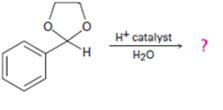
a)

Interpretation:
The products formed in the reaction given are to be identified. The mechanism of the reaction also is to be provided.
Concept introduction:
Acetal reacts with excess of water in the presence of acids to yield
To identify:
The products formed in the reaction given and to provide the mechanism of the reaction.
b)

Interpretation:
The products formed in the reaction given are to be identified. The mechanism of the reaction also is to be provided.
Concept introduction:
Acetal reacts with excess of water in the presence of acids to yield aldehydes and ketones. the steps involved are protonation, nucleophilic substitution, proton transfer, another nucleophilic substitution and heterolysis.
To identify:
The products formed in the reaction given and to provide the mechanism of the reaction.
c)

Interpretation:
The products formed in the reaction given are to be identified. The mechanism of the reaction also is to be provided.
Concept introduction:
Acetal reacts with excess of water in the presence of acids to yield aldehydes and ketones. the steps involved are protonation, nucleophilic substitution, proton transfer, another nucleophilic substitution and heterolysis.
To identify:
The products formed in the reaction given and to provide the mechanism of the reaction.
d)

Interpretation:
The products formed in the reaction given are to be identified. The mechanism of the reaction also is to be provided.
Concept introduction:
Acetal reacts with excess of water in the presence of acids to yield aldehydes and ketones. the steps involved are protonation, nucleophilic substitution, proton transfer, another nucleophilic substitution and heterolysis.
To identify:
The product formed in the reaction given and to provide the mechanism of the reaction.
Trending nowThis is a popular solution!

Chapter 19 Solutions
Organic Chemistry
